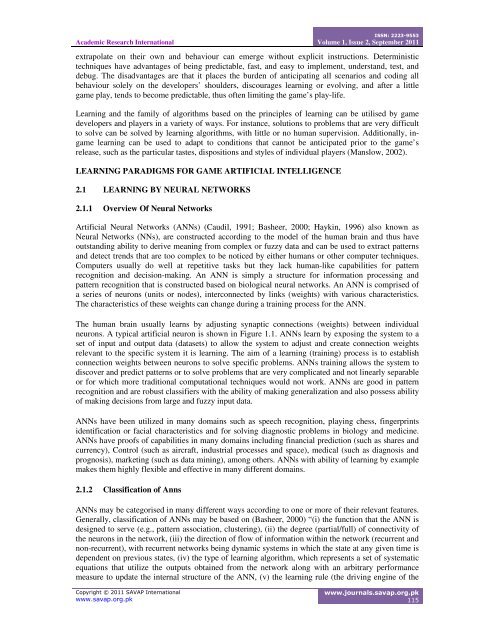Vol. 1(2) SEP 2011 - SAVAP International
Vol. 1(2) SEP 2011 - SAVAP International
Vol. 1(2) SEP 2011 - SAVAP International
You also want an ePaper? Increase the reach of your titles
YUMPU automatically turns print PDFs into web optimized ePapers that Google loves.
Academic Research <strong>International</strong><br />
ISSN: 2223-9553<br />
<strong>Vol</strong>ume 1, Issue 2, September <strong>2011</strong><br />
extrapolate on their own and behaviour can emerge without explicit instructions. Deterministic<br />
techniques have advantages of being predictable, fast, and easy to implement, understand, test, and<br />
debug. The disadvantages are that it places the burden of anticipating all scenarios and coding all<br />
behaviour solely on the developers’ shoulders, discourages learning or evolving, and after a little<br />
game play, tends to become predictable, thus often limiting the game’s play-life.<br />
Learning and the family of algorithms based on the principles of learning can be utilised by game<br />
developers and players in a variety of ways. For instance, solutions to problems that are very difficult<br />
to solve can be solved by learning algorithms, with little or no human supervision. Additionally, ingame<br />
learning can be used to adapt to conditions that cannot be anticipated prior to the game’s<br />
release, such as the particular tastes, dispositions and styles of individual players (Manslow, 2002).<br />
LEARNING PARADIGMS FOR GAME ARTIFICIAL INTELLIGENCE<br />
2.1 LEARNING BY NEURAL NETWORKS<br />
2.1.1 Overview Of Neural Networks<br />
Artificial Neural Networks (ANNs) (Caudil, 1991; Basheer, 2000; Haykin, 1996) also known as<br />
Neural Networks (NNs), are constructed according to the model of the human brain and thus have<br />
outstanding ability to derive meaning from complex or fuzzy data and can be used to extract patterns<br />
and detect trends that are too complex to be noticed by either humans or other computer techniques.<br />
Computers usually do well at repetitive tasks but they lack human-like capabilities for pattern<br />
recognition and decision-making. An ANN is simply a structure for information processing and<br />
pattern recognition that is constructed based on biological neural networks. An ANN is comprised of<br />
a series of neurons (units or nodes), interconnected by links (weights) with various characteristics.<br />
The characteristics of these weights can change during a training process for the ANN.<br />
The human brain usually learns by adjusting synaptic connections (weights) between individual<br />
neurons. A typical artificial neuron is shown in Figure 1.1. ANNs learn by exposing the system to a<br />
set of input and output data (datasets) to allow the system to adjust and create connection weights<br />
relevant to the specific system it is learning. The aim of a learning (training) process is to establish<br />
connection weights between neurons to solve specific problems. ANNs training allows the system to<br />
discover and predict patterns or to solve problems that are very complicated and not linearly separable<br />
or for which more traditional computational techniques would not work. ANNs are good in pattern<br />
recognition and are robust classifiers with the ability of making generalization and also possess ability<br />
of making decisions from large and fuzzy input data.<br />
ANNs have been utilized in many domains such as speech recognition, playing chess, fingerprints<br />
identification or facial characteristics and for solving diagnostic problems in biology and medicine.<br />
ANNs have proofs of capabilities in many domains including financial prediction (such as shares and<br />
currency), Control (such as aircraft, industrial processes and space), medical (such as diagnosis and<br />
prognosis), marketing (such as data mining), among others. ANNs with ability of learning by example<br />
makes them highly flexible and effective in many different domains.<br />
2.1.2 Classification of Anns<br />
ANNs may be categorised in many different ways according to one or more of their relevant features.<br />
Generally, classification of ANNs may be based on (Basheer, 2000) “(i) the function that the ANN is<br />
designed to serve (e.g., pattern association, clustering), (ii) the degree (partial/full) of connectivity of<br />
the neurons in the network, (iii) the direction of flow of information within the network (recurrent and<br />
non-recurrent), with recurrent networks being dynamic systems in which the state at any given time is<br />
dependent on previous states, (iv) the type of learning algorithm, which represents a set of systematic<br />
equations that utilize the outputs obtained from the network along with an arbitrary performance<br />
measure to update the internal structure of the ANN, (v) the learning rule (the driving engine of the<br />
Copyright © <strong>2011</strong> <strong>SAVAP</strong> <strong>International</strong><br />
www.savap.org.pk<br />
www.journals.savap.org.pk<br />
115

















